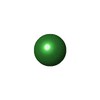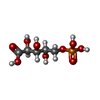[English] 日本語
 Yorodumi
Yorodumi- PDB-1qxr: Crystal structure of phosphoglucose isomerase from Pyrococcus fur... -
+ Open data
Open data
- Basic information
Basic information
| Entry | Database: PDB / ID: 1qxr | ||||||
|---|---|---|---|---|---|---|---|
| Title | Crystal structure of phosphoglucose isomerase from Pyrococcus furiosus in complex with 5-phosphoarabinonate | ||||||
 Components Components | Glucose-6-phosphate isomerase | ||||||
 Keywords Keywords |  ISOMERASE / ISOMERASE /  phosphoglucose isomerase / cupin fold / phosphoglucose isomerase / cupin fold /  Pyrococcus furiosus / Pyrococcus furiosus /  hyperthermophile / hyperthermophile /  extremophile / aldose-ketose isomerase extremophile / aldose-ketose isomerase | ||||||
| Function / homology |  Function and homology information Function and homology information glucose-6-phosphate isomerase / glucose-6-phosphate isomerase /  glucose-6-phosphate isomerase activity / glucose-6-phosphate isomerase activity /  gluconeogenesis / glycolytic process / iron ion binding / gluconeogenesis / glycolytic process / iron ion binding /  cytoplasm cytoplasmSimilarity search - Function | ||||||
| Biological species |    Pyrococcus furiosus (archaea) Pyrococcus furiosus (archaea) | ||||||
| Method |  X-RAY DIFFRACTION / REFINEMENT / Resolution: 1.7 Å X-RAY DIFFRACTION / REFINEMENT / Resolution: 1.7 Å | ||||||
 Authors Authors | Swan, M.K. / Solomons, J.T.G. / Beeson, C.C. / Hansen, P. / Schonheit, P. / Davies, C. | ||||||
 Citation Citation |  Journal: J.Biol.Chem. / Year: 2003 Journal: J.Biol.Chem. / Year: 2003Title: Structural evidence for a hydride transfer mechanism of catalysis in phosphoglucose isomerase from Pyrococcus furiosus Authors: Swan, M.K. / Solomons, J.T.G. / Beeson, C.C. / Hansen, P. / Schonheit, P. / Davies, C. #1:  Journal: Protein Pept.Lett. / Year: 2003 Journal: Protein Pept.Lett. / Year: 2003Title: Crystallization and preliminary X-ray diffraction analysis of phosphoglucose isomerase from Pyrococcus furiosus Authors: Swan, M.K. / Hansen, P. / Schonheit, P. / Davies, C. | ||||||
| History |
| ||||||
| Remark 600 | HETEROGEN The carboxylate oxygens of 5-phosphoarabinonate are labeled O1 and O1A in the pdb file ...HETEROGEN The carboxylate oxygens of 5-phosphoarabinonate are labeled O1 and O1A in the pdb file whereas in the published paper describing this structure these atoms are referred to as O1A and O1B, respectively. |
- Structure visualization
Structure visualization
| Structure viewer | Molecule:  Molmil Molmil Jmol/JSmol Jmol/JSmol |
|---|
- Downloads & links
Downloads & links
- Download
Download
| PDBx/mmCIF format |  1qxr.cif.gz 1qxr.cif.gz | 90.8 KB | Display |  PDBx/mmCIF format PDBx/mmCIF format |
|---|---|---|---|---|
| PDB format |  pdb1qxr.ent.gz pdb1qxr.ent.gz | 68.7 KB | Display |  PDB format PDB format |
| PDBx/mmJSON format |  1qxr.json.gz 1qxr.json.gz | Tree view |  PDBx/mmJSON format PDBx/mmJSON format | |
| Others |  Other downloads Other downloads |
-Validation report
| Arichive directory |  https://data.pdbj.org/pub/pdb/validation_reports/qx/1qxr https://data.pdbj.org/pub/pdb/validation_reports/qx/1qxr ftp://data.pdbj.org/pub/pdb/validation_reports/qx/1qxr ftp://data.pdbj.org/pub/pdb/validation_reports/qx/1qxr | HTTPS FTP |
|---|
-Related structure data
| Related structure data | 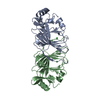 1qxjSC 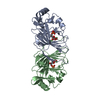 1qy4C S: Starting model for refinement C: citing same article ( |
|---|---|
| Similar structure data |
- Links
Links
- Assembly
Assembly
| Deposited unit | 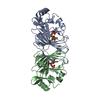
| ||||||||
|---|---|---|---|---|---|---|---|---|---|
| 1 |
| ||||||||
| Unit cell |
|
- Components
Components
| #1: Protein |  / GPI / Phosphoglucose isomerase / PGI / Phosphohexose isomerase / PHI / GPI / Phosphoglucose isomerase / PGI / Phosphohexose isomerase / PHIMass: 21505.436 Da / Num. of mol.: 2 Source method: isolated from a genetically manipulated source Source: (gene. exp.)    Pyrococcus furiosus (archaea) / Gene: PGIA OR PF0196 / Plasmid: pet17b / Species (production host): Escherichia coli / Production host: Pyrococcus furiosus (archaea) / Gene: PGIA OR PF0196 / Plasmid: pet17b / Species (production host): Escherichia coli / Production host:   Escherichia coli BL21 (bacteria) / Strain (production host): BL21 / References: UniProt: P83194, Escherichia coli BL21 (bacteria) / Strain (production host): BL21 / References: UniProt: P83194,  glucose-6-phosphate isomerase glucose-6-phosphate isomerase#2: Chemical |  Nickel Nickel#3: Sugar | #4: Water | ChemComp-HOH / |  Water Water |
|---|
-Experimental details
-Experiment
| Experiment | Method:  X-RAY DIFFRACTION / Number of used crystals: 1 X-RAY DIFFRACTION / Number of used crystals: 1 |
|---|
- Sample preparation
Sample preparation
| Crystal | Density Matthews: 2.3 Å3/Da / Density % sol: 45 % | ||||||||||||||||||||||||
|---|---|---|---|---|---|---|---|---|---|---|---|---|---|---|---|---|---|---|---|---|---|---|---|---|---|
Crystal grow | Temperature: 295 K / Method: vapor diffusion, hanging drop / pH: 5.6 Details: 25% PEG 4000, 0.2M ammonium acetate, 0.1M sodium acetate, pH 5.6, VAPOR DIFFUSION, HANGING DROP, temperature 295K | ||||||||||||||||||||||||
| Crystal grow | *PLUS Method: vapor diffusion, hanging drop | ||||||||||||||||||||||||
| Components of the solutions | *PLUS
|
-Data collection
| Diffraction | Mean temperature: 100 K |
|---|---|
| Diffraction source | Source:  ROTATING ANODE / Type: RIGAKU RUH3R / Wavelength: 1.5418 Å ROTATING ANODE / Type: RIGAKU RUH3R / Wavelength: 1.5418 Å |
| Detector | Type: RIGAKU RAXIS IV / Detector: IMAGE PLATE / Date: Jul 4, 2003 / Details: mirrors |
| Radiation | Monochromator: Osmic mirrors / Protocol: SINGLE WAVELENGTH / Monochromatic (M) / Laue (L): M / Scattering type: x-ray |
| Radiation wavelength | Wavelength : 1.5418 Å / Relative weight: 1 : 1.5418 Å / Relative weight: 1 |
| Reflection | Resolution: 1.7→36.8 Å / Num. obs: 38279 / % possible obs: 92.5 % / Observed criterion σ(F): 0 / Observed criterion σ(I): 0 / Redundancy: 2.7 % / Biso Wilson estimate: 23.6 Å2 / Rmerge(I) obs: 0.041 / Net I/σ(I): 12.5 |
| Reflection shell | Resolution: 1.7→1.76 Å / Redundancy: 2.7 % / Rmerge(I) obs: 0.297 / Mean I/σ(I) obs: 3.3 / Num. unique all: 3618 / % possible all: 88.2 |
| Reflection | *PLUS Num. obs: 38270 / Num. measured all: 103907 |
| Reflection shell | *PLUS % possible obs: 88.2 % |
- Processing
Processing
| Software |
| |||||||||||||||||||||||||||||||||||||||||||||||||||||||||||||||||||||||||||
|---|---|---|---|---|---|---|---|---|---|---|---|---|---|---|---|---|---|---|---|---|---|---|---|---|---|---|---|---|---|---|---|---|---|---|---|---|---|---|---|---|---|---|---|---|---|---|---|---|---|---|---|---|---|---|---|---|---|---|---|---|---|---|---|---|---|---|---|---|---|---|---|---|---|---|---|---|
| Refinement | Method to determine structure : REFINEMENT : REFINEMENTStarting model: 1QXJ Resolution: 1.7→15 Å / Cor.coef. Fo:Fc: 0.954 / Cor.coef. Fo:Fc free: 0.934 / SU B: 4.52 / SU ML: 0.142 / Cross valid method: THROUGHOUT / σ(F): 0 / ESU R: 0.144 / ESU R Free: 0.139 / Stereochemistry target values: MAXIMUM LIKELIHOOD
| |||||||||||||||||||||||||||||||||||||||||||||||||||||||||||||||||||||||||||
| Solvent computation | Ion probe radii: 0.8 Å / Shrinkage radii: 0.8 Å / VDW probe radii: 1.4 Å / Solvent model: BABINET MODEL WITH MASK | |||||||||||||||||||||||||||||||||||||||||||||||||||||||||||||||||||||||||||
| Displacement parameters | Biso mean: 29.621 Å2
| |||||||||||||||||||||||||||||||||||||||||||||||||||||||||||||||||||||||||||
| Refinement step | Cycle: LAST / Resolution: 1.7→15 Å
| |||||||||||||||||||||||||||||||||||||||||||||||||||||||||||||||||||||||||||
| Refine LS restraints |
| |||||||||||||||||||||||||||||||||||||||||||||||||||||||||||||||||||||||||||
| LS refinement shell | Resolution: 1.7→1.744 Å / Total num. of bins used: 20 /
| |||||||||||||||||||||||||||||||||||||||||||||||||||||||||||||||||||||||||||
| Software | *PLUS Version: 5 / Classification: refinement | |||||||||||||||||||||||||||||||||||||||||||||||||||||||||||||||||||||||||||
| Refinement | *PLUS Highest resolution: 1.7 Å | |||||||||||||||||||||||||||||||||||||||||||||||||||||||||||||||||||||||||||
| Solvent computation | *PLUS | |||||||||||||||||||||||||||||||||||||||||||||||||||||||||||||||||||||||||||
| Displacement parameters | *PLUS | |||||||||||||||||||||||||||||||||||||||||||||||||||||||||||||||||||||||||||
| Refine LS restraints | *PLUS
|
 Movie
Movie Controller
Controller



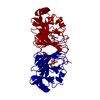


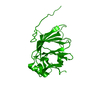
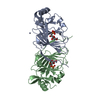



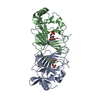
 PDBj
PDBj

